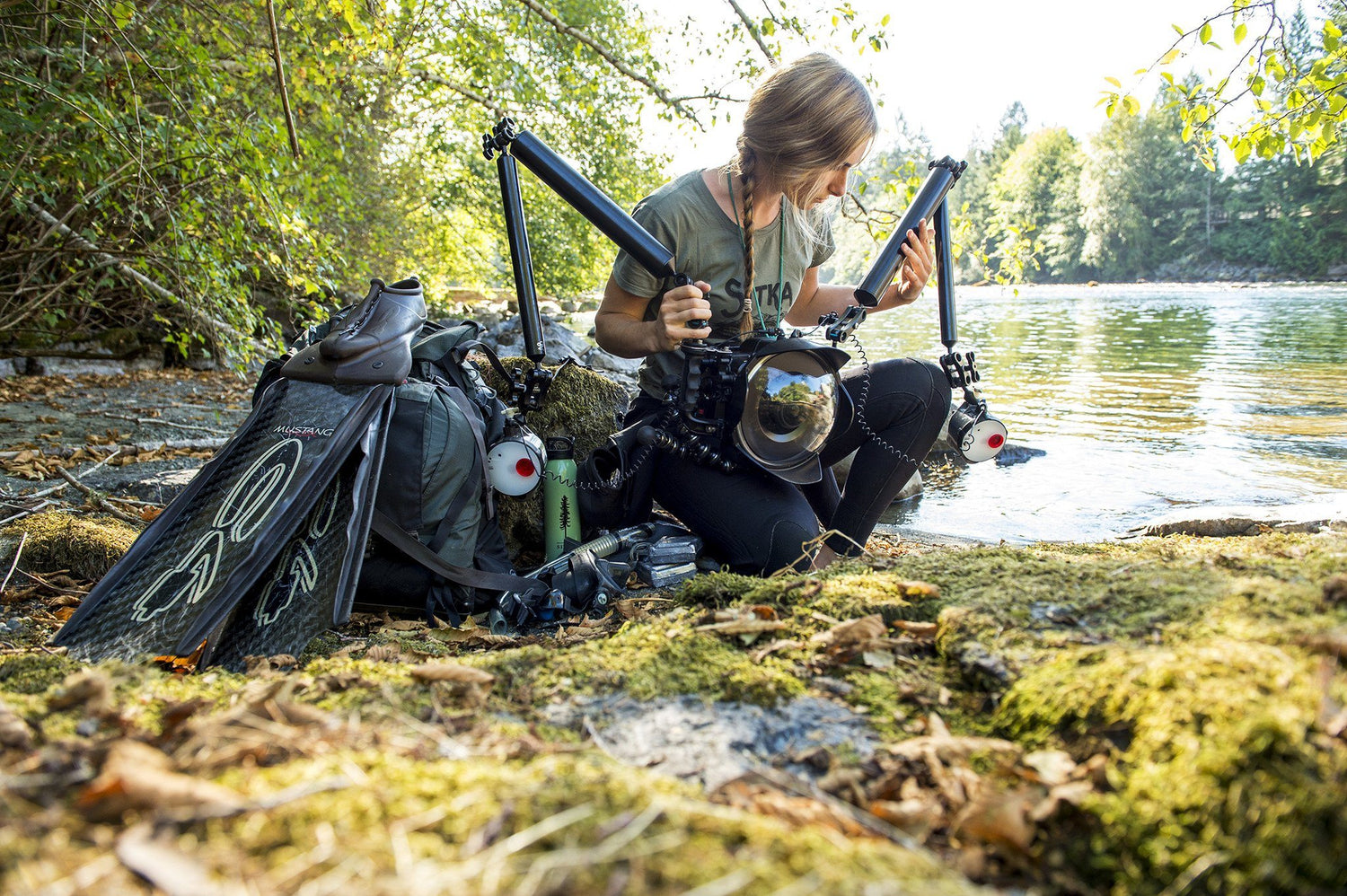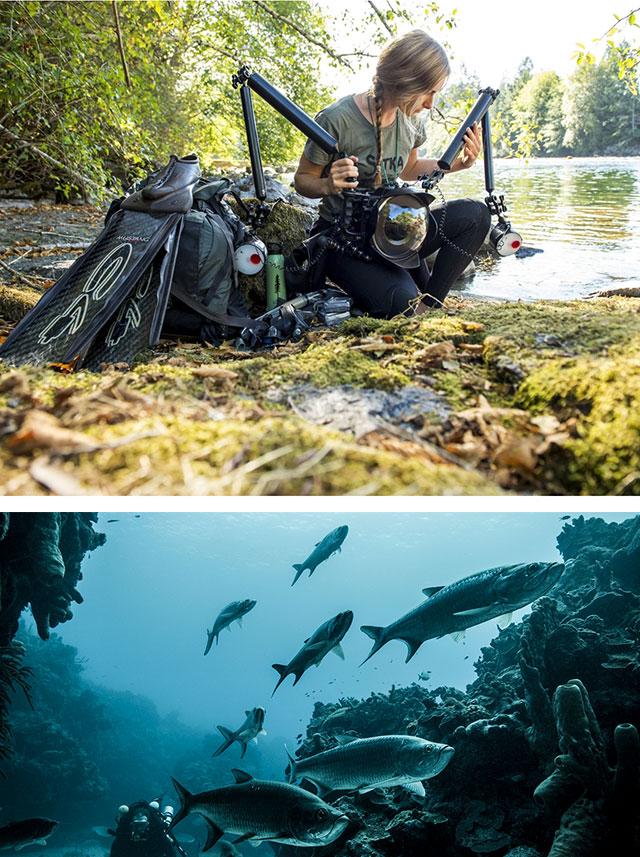
April Bencze prepares to freedive into the Campbell River wearing a Sitka tee. Photo provided.
"September rains greet and join the river as we crawl from our nest still soggy from the night; slip into damp wetsuits and join the salmon below. It's tough to untangle these colours from the fall season. Freshly rusted leaves tumble from trees above; sinking into the periphery as we watch the fish stream by. It's like the seasons are listening to the fish; waiting for a cue to shift. As if in celebration of this momentous return of life, the trees turn gold to pay their respects to the spawn. The salmon make their way up river for the first and final time, passing beneath overhanging branches stretched out like arms cheering them on. Soon these very salmon below will feed these very trees above. When the seasons eventually shift to spring, the bodies of these fish will help replace these fallen leaves."
- April Bencze
Ecologyst (Sitka) activist and nomadic wildlife photographer April Bencze recently hiked with 75 pounds of underwater camera equipment to the banks of the Campbell River on Vancouver Island, B.C. Bencze prepared to freedive into the water and capture early moments of the local salmon run. That means diving underwater without a breathing apparatus and relying on her ability to hold her breath.
“All of these photos are made by diving down on a single breath. . . Diving down for only a minute or two to capture these moments underwater is tough, especially when you look like a seal (who love to eat salmon) in your black wetsuit,” says Bencze.
She explains diving slowly to the bottom and waiting for the salmon to feel comfortable enough to stream overhead or completely envelope her into their school. She must compose her shot while keeping in mind when it’s time to resurface and restock her lungs with air.
Photo from Bencze's Instagram: @aprilbencze
Bencze describes the photographic mission as an effort to “boost wild salmon appreciation and awareness, and to help inspire people to protect rivers and wild salmon from the many threats they face.”
So, what’s at risk for West Coast salmon?
The federal government says that Canadian aquaculture really took off in the 1970’s. In 2000, the Department of Fisheries and Oceans issued a report explaining that wild Pacific salmon populations have been decreasing since the 1990’s, with aquaculture seen as possible reason for the decline. According to Pacific Wild’s online report, scientists first noticed farmed Atlantic salmon trying to spawn in a Vancouver Island stream around 1991. This initially sparked fear that farming the invasive species in B.C. may negatively affect wild fish.
The Fraser River, which runs into the Georgia Strait near Vancouver, is B.C.’s longest river. In 2009, a massive decline in the number of sockeye salmon returning to spawn in its waterways had enough impact to push the Conservative government into action.
The government appointed Supreme Court Justice Bruce Cohen to lead an inquiry into the stock collapse. Cohen’s 2012 report includes 75 recommendations. It specifically highlights Discovery Island near Campbell River, suggesting that fish farm operations should be immediately limited in the region while the Department of Fisheries and Oceans conducts a disease risk assessment. The assessment is due to finalize in four years.
In September, the Vancouver Sun reported that the Fraser River is facing an even worse sockeye return this year: “The estimated one million returning fish are 400,000 less than the crisis that initiated the Cohen Commission — so low that all fishing in the lower Fraser has been banned, including the test fishery,” reports Ray Grigg.
The question of whether aquaculture is to blame for the decreasing salmon populations has yet to be answered. Other suspected factors include general water pollution and predator threat.
Pacific Wild’s website addresses some risks of aquaculture: “Open net pen fish farms pose ongoing problems in the form of fish escapes, disease transfer and fish waste pollution in the adjacent marine environment. Though public pressure has led to better regulations and reporting on sea lice, the same can't be said for disease outbreaks at fish farms.”
However, the aquaculture industry and communities who support it stress the economic importance of salmon farming. The most current (2012) government statistic reports that aquaculture creates around 6,000 jobs in BC, generating wages of $244 million. Salmon farming is B.C.’s largest agricultural export.
The Times Colonist recently reported that the federal government has announced plans to invest in the hiring of more scientists to uncover sufficient evidence explaining the declines. This could take us closer to finding out whether aquaculture is a real threat.
In the meantime, advocating for salmon seems most important—and if anyone knows this, it’s April Bencze:
“I learn time and time again, in a thousand different ways, that we are not separate from the natural world. . . This lesson of connectivity inspires me to act with the wild in mind everyday, to know where the fish I eat comes from, to know if their population is sustainable enough to consume.”
Bencze’s photography not only celebrates nature and its awe-inspiring inhabitants, but also promotes an important momentum of conservation.
“Every time I take photos of wildlife, whether it be salmon or the wolves fishing for them, I am reconnected to the natural world I am a part of, and that inspires me to protect these places and lives that are ultimately not separate from myself.”

Bencze hikes with her equipment. Photo provided.


